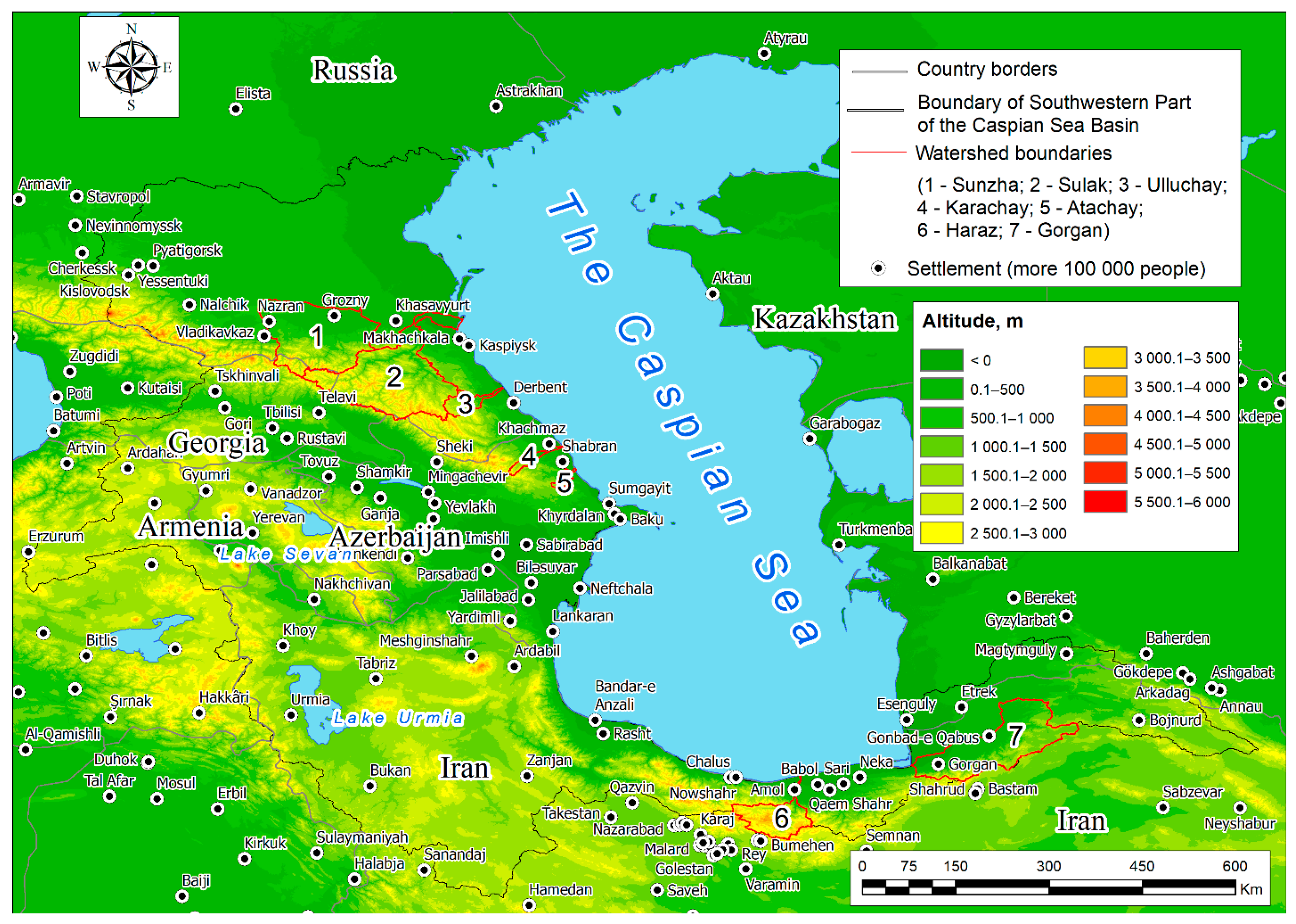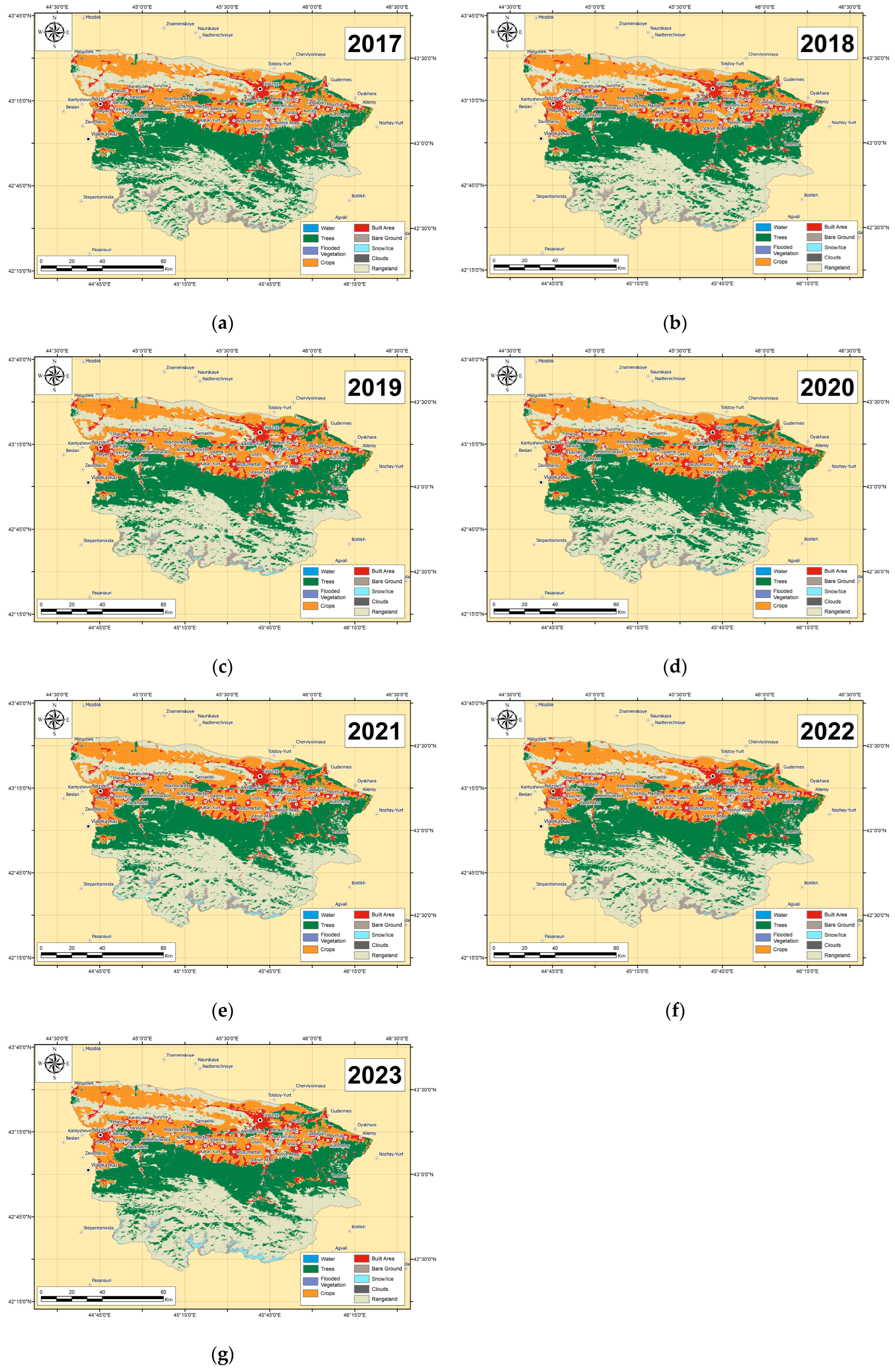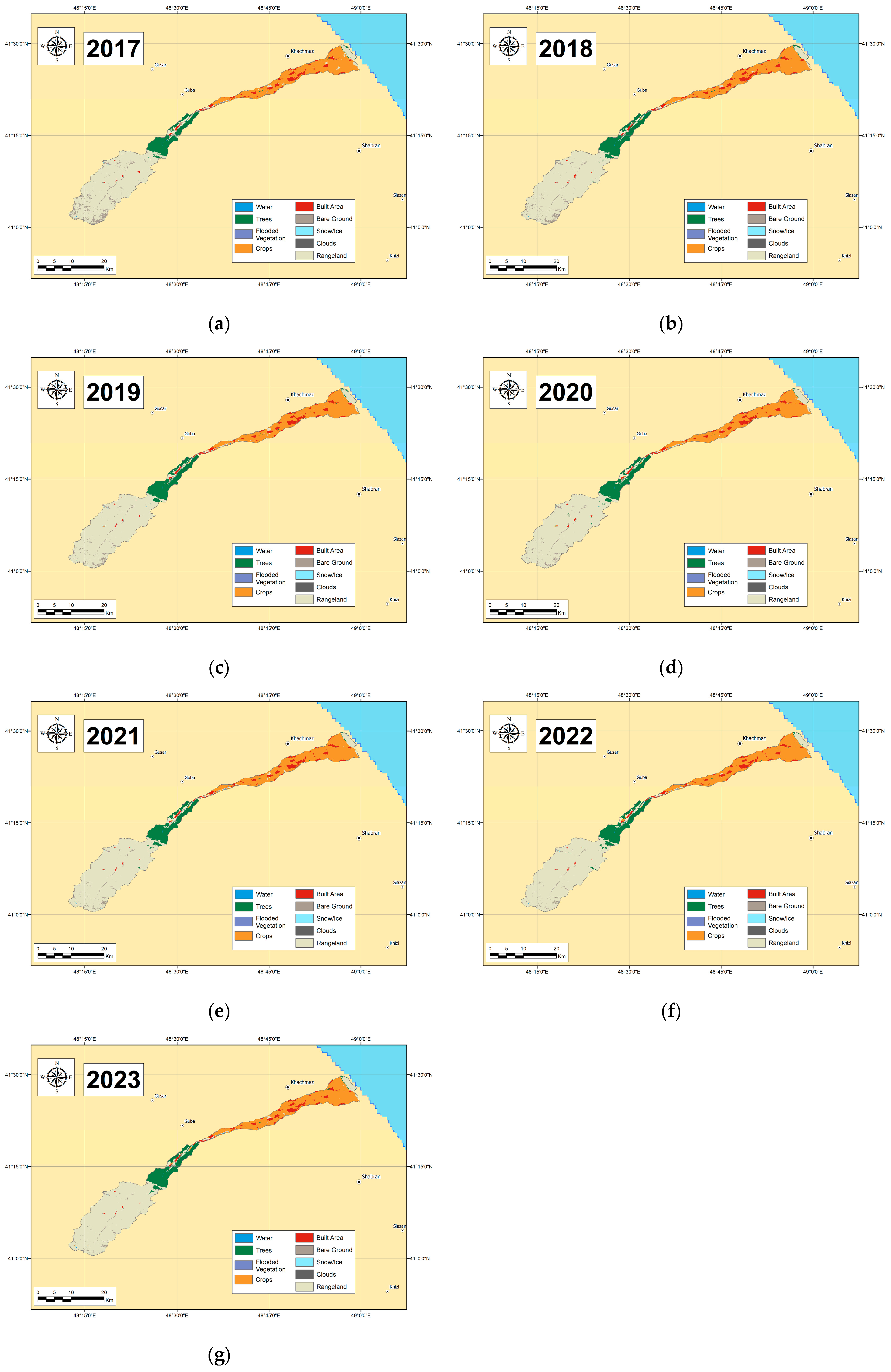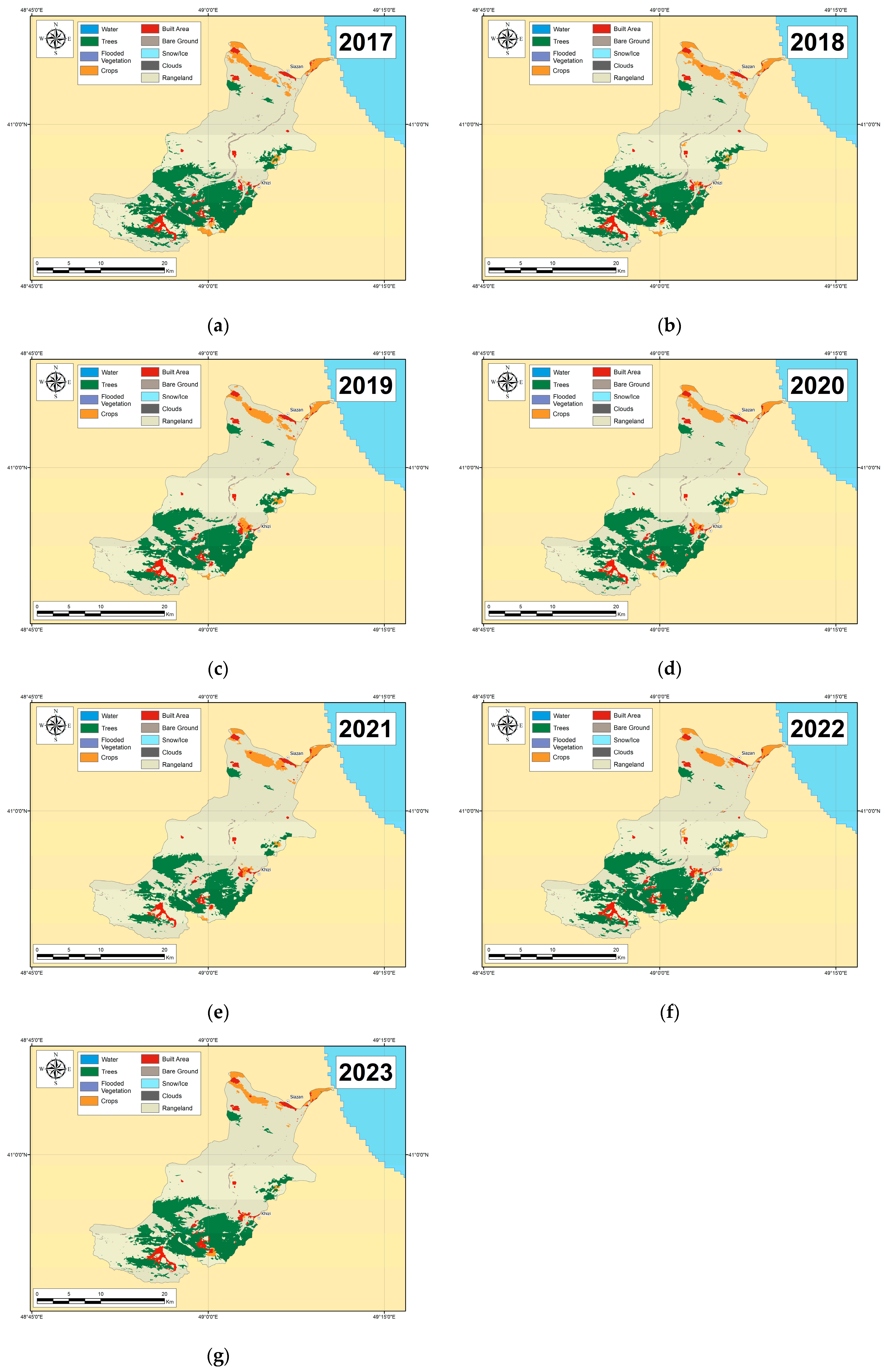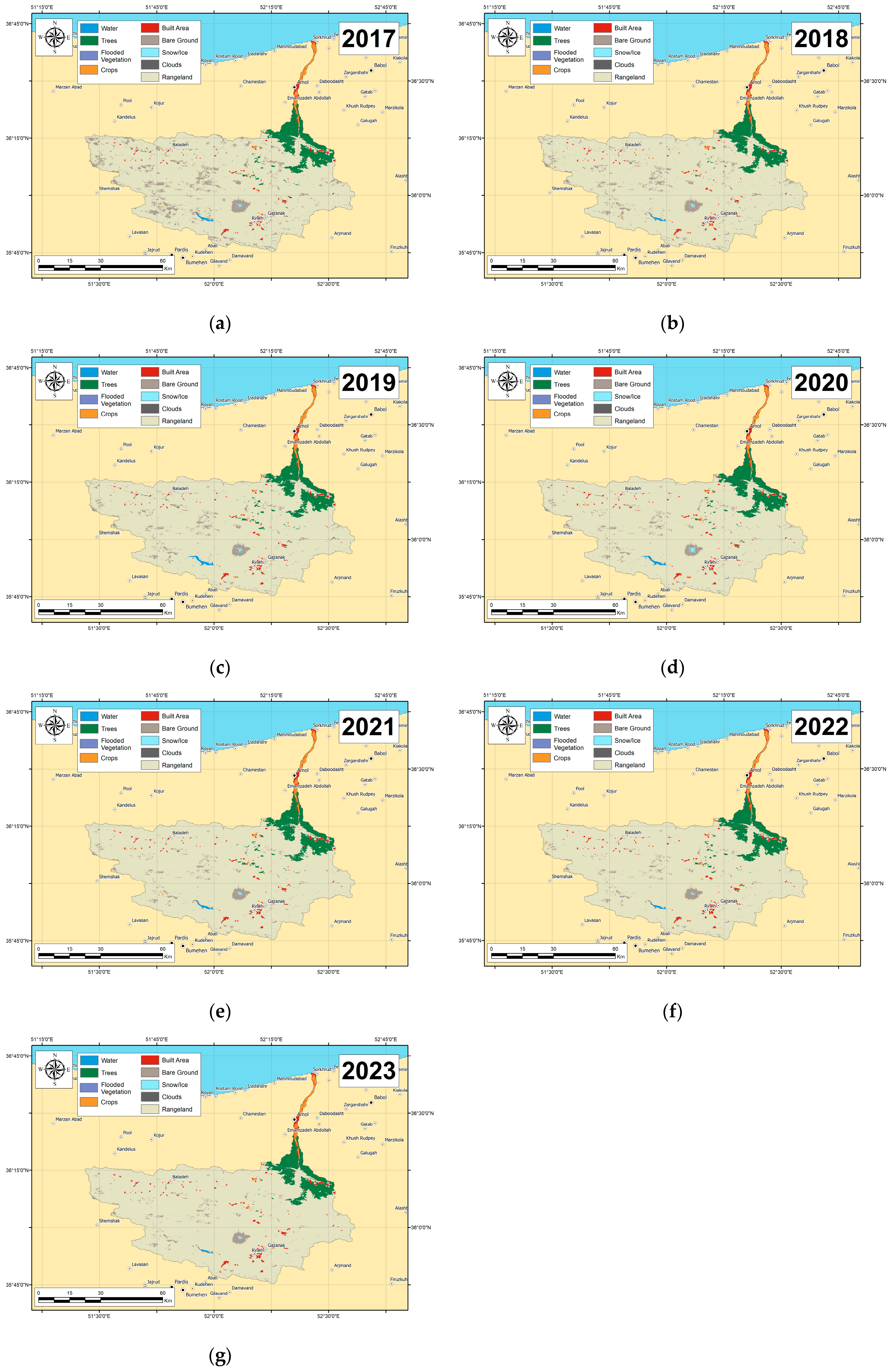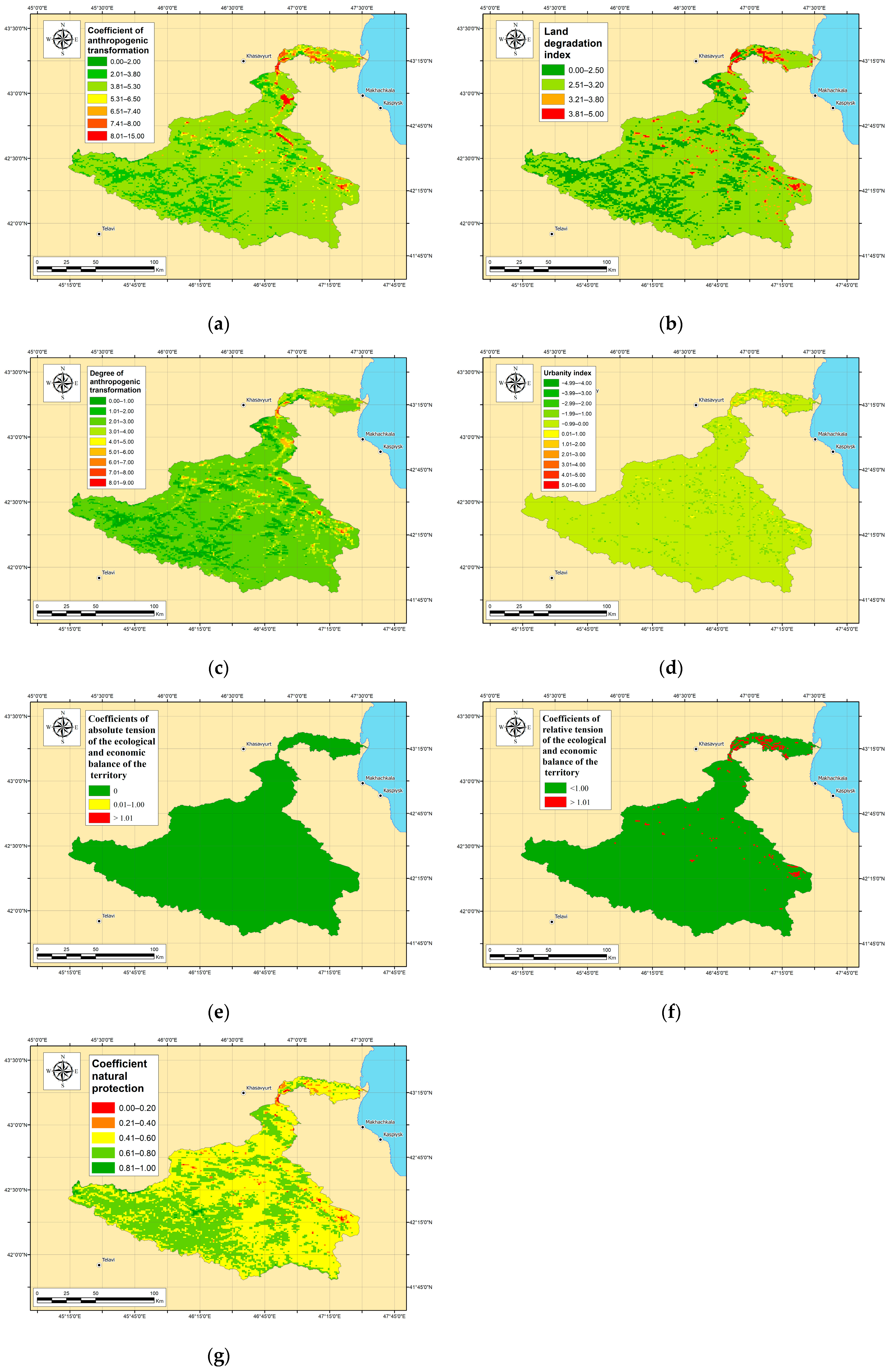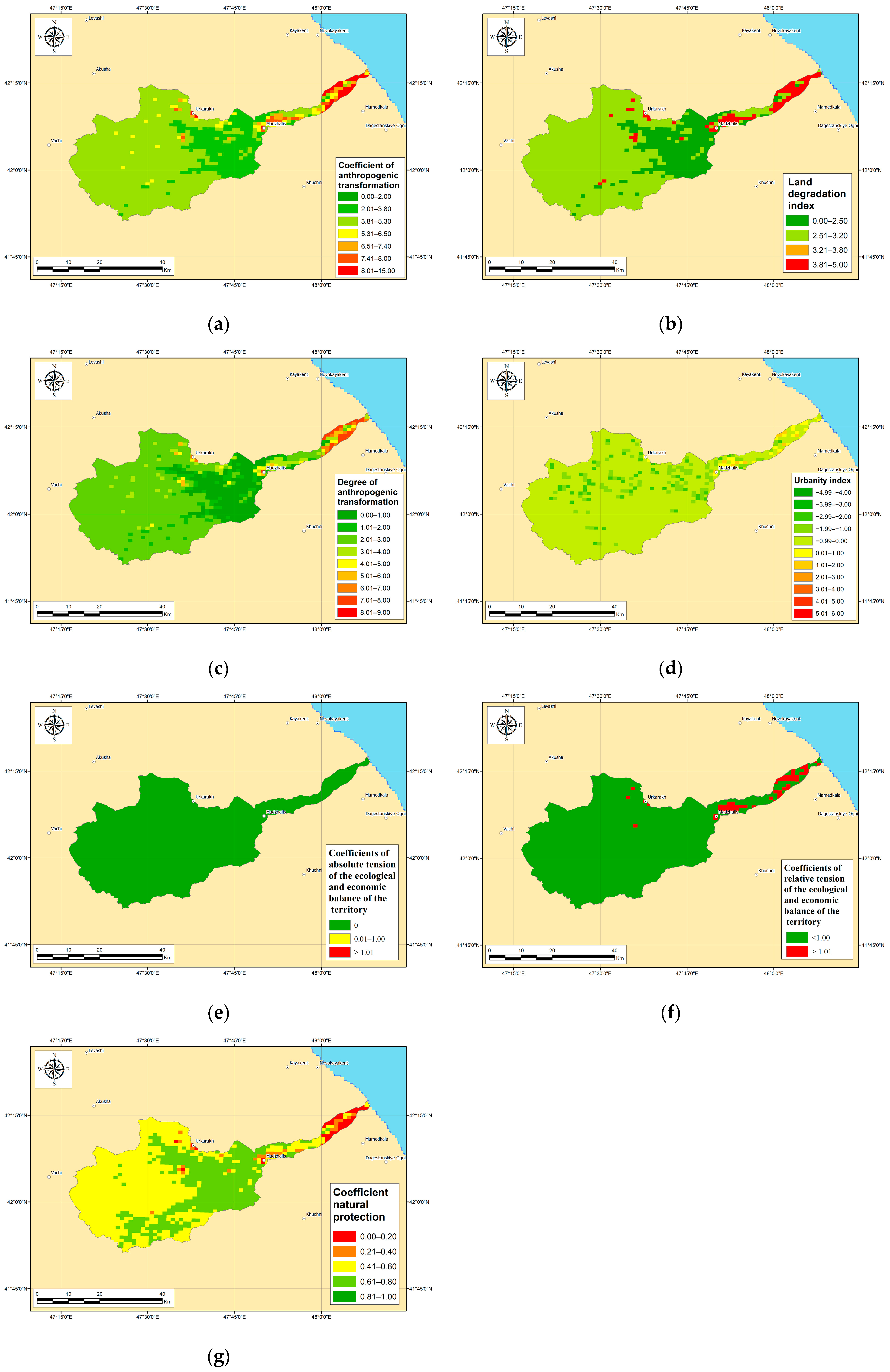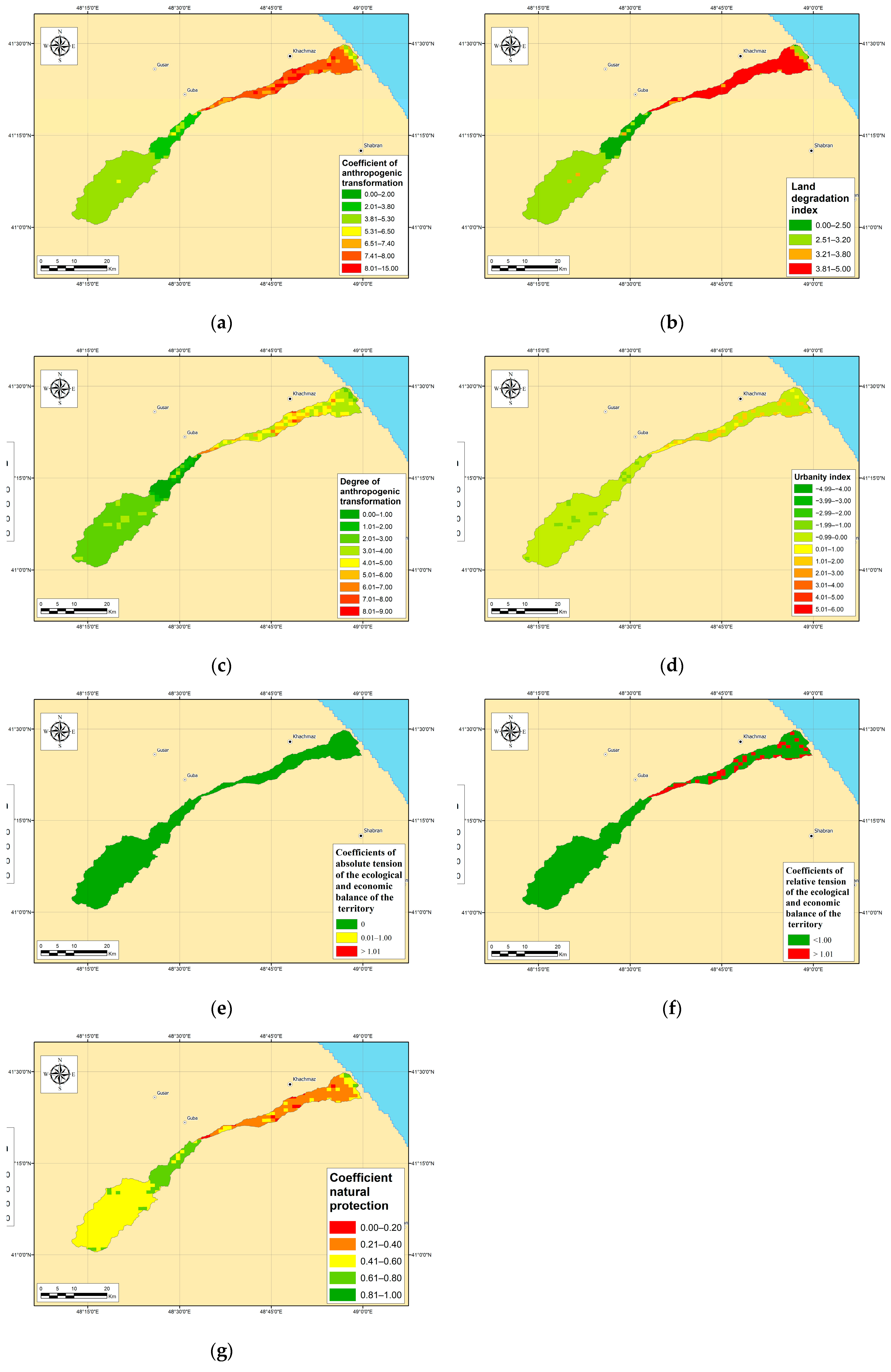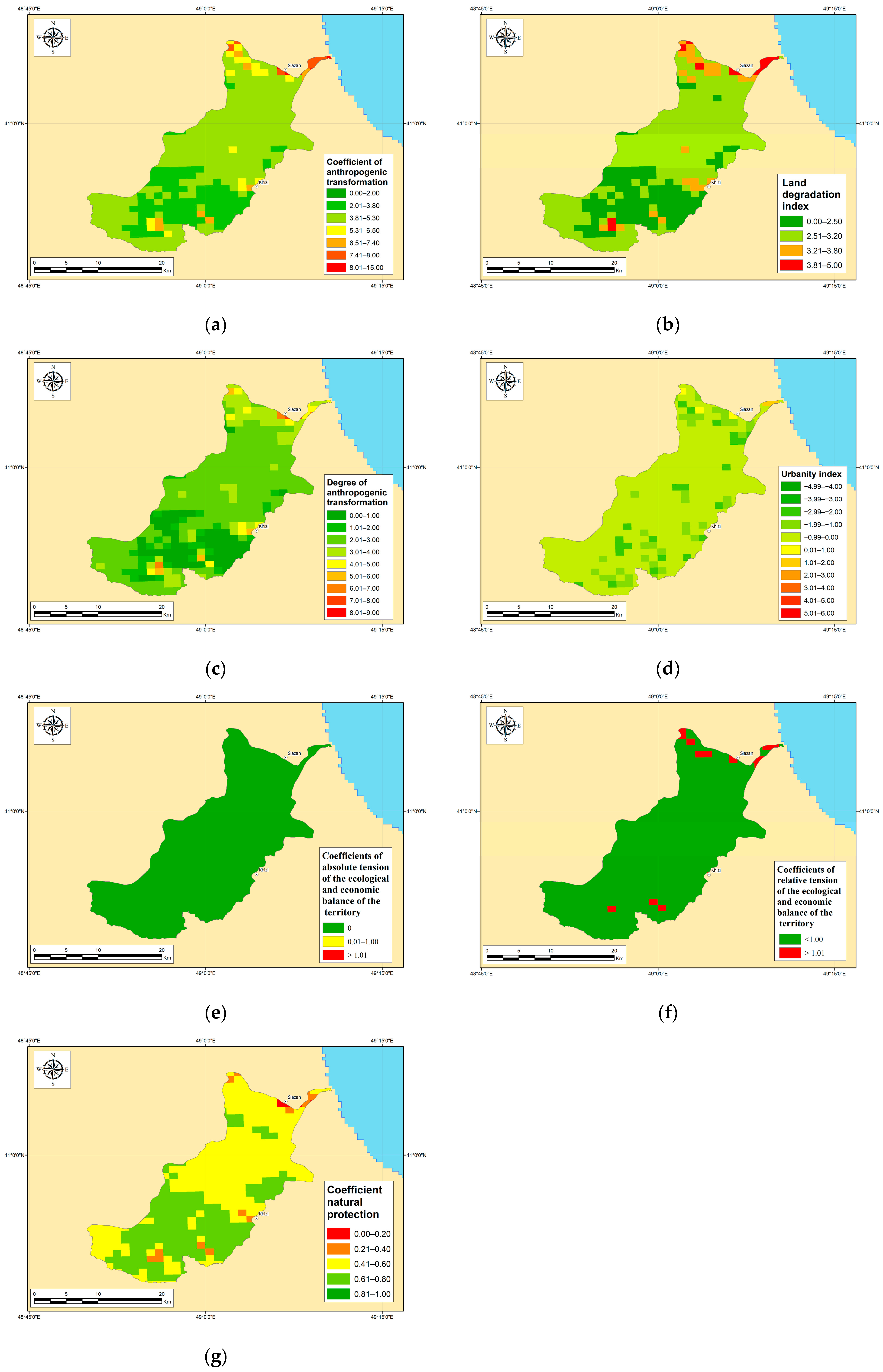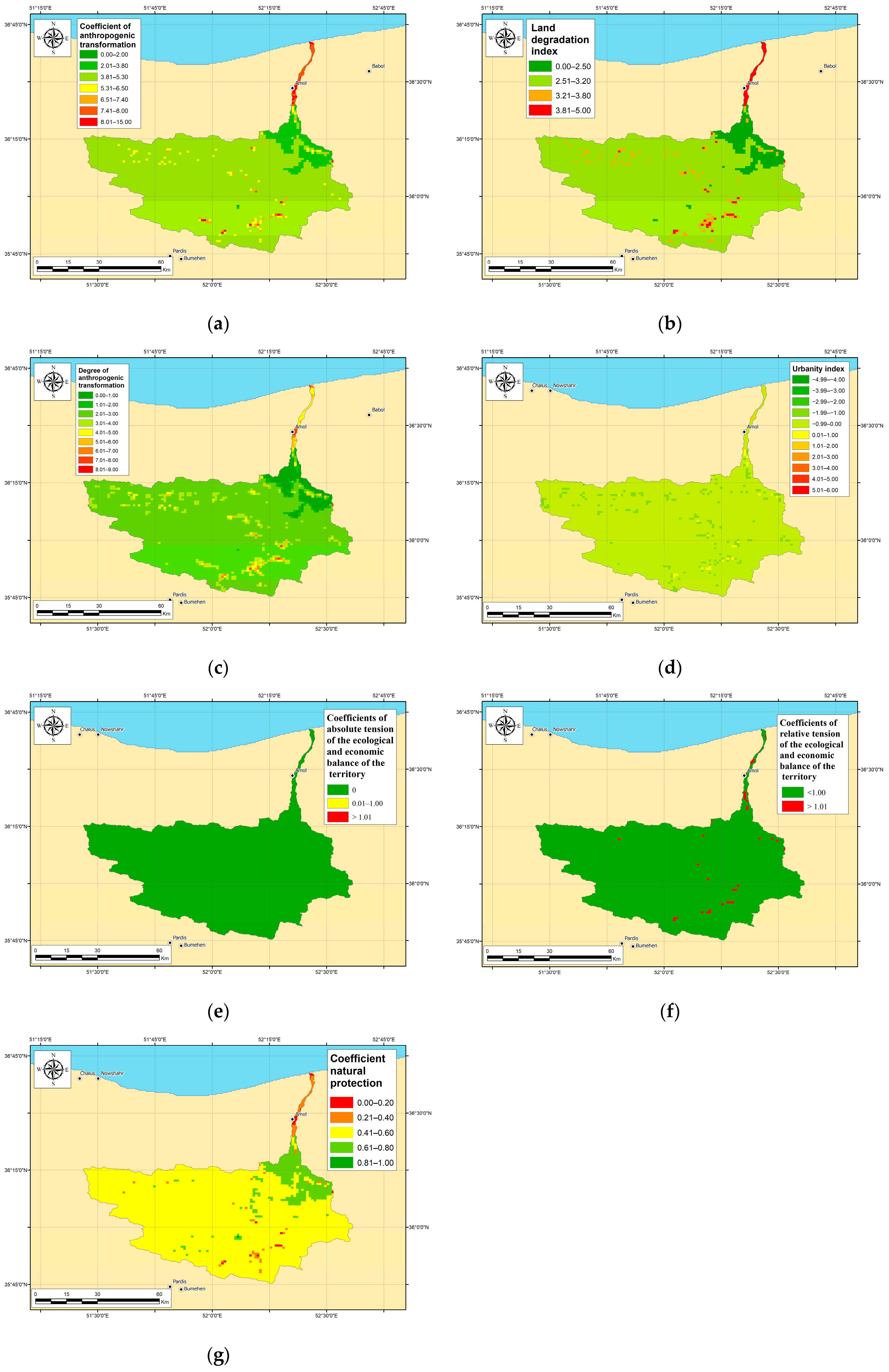Nature Management in the Russian Federation (Republic of Dagestan and Chechen Republic)
- (1)
Nature Management in the Republic of Dagestan
The Republic of Dagestan’s forest fund covers 527.9 thousand hectares, representing 10.5% of its total area. Within this fund, 449.1 thousand hectares (85.0%) are forests. 364 thousand hectares are currently forested and 78.8 thousand hectares (15.0%) formerly belonging to agriculture have no management materials. The area with forest cover is 365.1 thousand hectares. Forested areas represent 7.3% of the Republic, but forest cover varies depending on location with less forests in the semi-desert and highland subalpine transition zones. Importantly, all forests within the Republic of Dagestan have protected status and are considered valuable [
56], which aids in the conservation of forests outside the protected areas.
The Republic of Dagestan has established an extensive network of protected areas (PAs). There are 50 PAs of regional and local importance, covering 397,045.05 hectares, alongside five federally managed sites totaling 191,774 hectares. These include the Dagestansky Reserve (19,061 ha), the Samursky National Park (48,273 ha), the Agrakhansky Federal Sanctuary (39,000 ha), the Samursky Federal Sanctuary (1940 ha), and the Tlyaratinsky Federal Sanctuary (83,500 ha). Overall, protected areas account for 11.7% of the Republic of Dagestan’s territory [
56].
The industrial potential of Dagestan’s mineral resource base remains largely untapped, except for oil, gas, and construction materials. Ore resource development is currently non-existent. The primary mineral resources extracted from Dagestan’s subsoil include oil, gas, groundwater (fresh, mineral, and thermal), seashells (for animal and poultry feed), and construction materials (limestone for sawing and facing, brick clays, sands, rubble, and sand–gravel mixtures). The main companies exploiting these resources are JSC “NK “Rosneft”-Dagneft” and JSC “Dagneftegaz” [
56].
Industrial production primarily consists of manufacturing from the machine-building sector and light industry. The current breakdown is as follows: food and beverage production (over 53%); non-metallic mineral product manufacturing (over 14%); machinery and equipment manufacturing (excluding otherwise classified items) and the production of other vehicles and equipment (9.5%); computer, electronic, and optical product and electrical equipment manufacturing (7%); furniture and other finished goods production (over 6%); coke, refined petroleum product, rubber and plastic product manufacturing (3.7%); machinery and equipment repair and installation (1.9%); metallurgical and finished metal product manufacturing (excluding machinery and equipment) (1.6%); and textile, clothing, and leather production (1.3%).
The territorial organization of Dagestan’s sectoral economy is characterized by a high concentration of industry in the Central and Northern zones, which are the most developed and urbanized areas, and a lower concentration in the Southern zone. Industry remains relatively underdeveloped in the mountainous regions of Dagestan, despite significant potential for energy development (including renewable sources) and the food industry, which has been largely unexploited for decades.
Situated at the crossroads of international transportation routes, the Republic of Dagestan links “North-South” and “East-West” transport flows. Consequently, Dagestan is one of the few regions in the Russian Federation with developed infrastructure for nearly all modes of transport: rail, road, sea, air, and pipeline, including transport hubs and a network of intermodal and multimodal transport and logistics complexes. Dagestan’s density of paved public roads of federal, regional, intermunicipal, and local significance is 6.6 times higher than the Russian average [
57].
Agricultural land accounts for 86.4% (4344.5 thousand hectares) of the land use in the Republic of Dagestan. Agriculture also significantly contributes to the economy, representing over 15% of the Gross Regional Product (GRP), which is nearly four times the national average for Russia. Dagestan’s specialization in agriculture is evident within the interregional division of labor in the North Caucasian Federal District (NCFD), with certain agricultural sectors exhibiting specialization levels comparable to those seen nationwide.
Agriculture is dispersed throughout the Republic of Dagestan, but the majority of agricultural production is concentrated in the mountainous (including the lowland “kutan” farms of the mountainous zone) and central zones. The region’s primary agricultural specialization within the Russian Federation is animal husbandry, encompassing cattle (including cows), small livestock (sheep and goats), and poultry breeding, with the production of staple foods such as meat, milk, and eggs. Transhumance, or distant pasture animal husbandry, plays a significant role in this sector, influencing land organization in both mountainous and lowland areas. Crop production and related food products are also significant in Dagestan’s agricultural sector, including grains, industrial crops, fruits and berries, grapes, vegetables, melons, and potatoes. Notably, Dagestan’s agricultural production, particularly in crop cultivation, is characterized by small-scale farming. Households produce over 85% of this sector’s output, with particularly high percentages for potatoes, vegetables, and fruits (96–99%). This is further supported by comparing the production of key agricultural products among households in Dagestan, neighboring regions, and across the Russian Federation.
Over 100,000 hectares of arable land, a particularly scarce resource (Dagestan has five times less arable land per capita than the Russian average), remain unused for agriculture. This is primarily due to unresolved land-use issues and the outdated technical and technological infrastructure of the agricultural sector [
57].
Settlement lands in the Republic of Dagestan comprise 3.2% (160.5 thousand hectares) of the total land area. Residential land use is particularly prominent in the central part of Dagestan. This area includes the city districts of Makhachkala (the capital), Buynaksk, Izberbash, Kaspiysk, Kizilyurt, and Khasavyurt, as well as the municipal districts of Babayurtovsky, Buynaksky, Kazbekovsky, Karabudakhkentsky, Kayakentsky, Kumtorkalinsky, Kizilyurtovsky, Novolaksky, and Khasavyurtovsky. These areas are home to 57.8% of the Republic of Dagestan’s population. Central Dagestan functions as a major, multifaceted territorial zone within the Republic of Dagestan, characterized by developed industry, agro-industry, transport and logistics, a construction base, a tourism and recreation complex, and a business, scientific, and educational center. Southern Dagestan, with a population share of 19.5%, encompasses the city districts of Derbent and Dagestansky Ogni, as well as the following municipal districts: Agulsky, Dakhadaevsky, Derbentsky, Kaytagsky, Kurakhsky, Suleyman-Stalsky, Tabasaransky, Khivsky, Rutulsky, Akhtynsky, Dokuzparinsky, and Magaramkentsky. Key functions in Southern Dagestan include industry, agro-industry, tourism, recreation, and military/border-related activities. Northern Dagestan accounts for an even smaller portion of the population (7.7%) and comprises the city districts of Kizlyar and Yuzhno-Sukhokumsk and the municipal districts of Nogaysky, Kizlyarsky, Tarumovsky, and Babayurtovsky. This zone is primarily agro-industrial, although it also possesses developed industrial functions and hosts facilities of the defense–industrial complex. The main portion of mountainous Dagestan encompasses the municipal districts of Akhvakhsky, Botlikhsky, Gumbetovsky, Gergebilsky, Untsukulsky, Tlyaratinsky, Khunzakhsky, Shamilsky, Tsumadinsky, Tsuninsky, and the Bezhtinsky section, forming the “Untsukul Economic Zone” in the west. Additionally, it includes the Akushinsky, Gunibsky, Kulinsky, Laksky, Levashinsky, and Sergokalinsky districts. This mountainous area accounts for 16.6% of the population but remains largely underdeveloped economically [
57].
- (2)
Nature Management in the Chechen Republic
Forests cover a total area of 352.7 thousand hectares in the Chechen Republic, representing 21.8% of the republic’s total area. The average forest cover is 20.1%. The highest forest cover is found in the Shatoysky, Nozhay-Yurtovsky, and Vedensky districts (62.9%, 44.5%, and 42.5% respectively), whereas Shelkovsky, Naursky, and Nadterechny districts have significantly lower forest cover (6.1%, 4.7%, and 4.5%). All forests in the Chechen Republic are designated as protective forests, covering a total area of 352.7 thousand hectares, with 323.7 thousand hectares covered by forest vegetation, 329.7 thousand hectares classified as forest land, and 23.0 thousand hectares as non-forest land [
58].
Protected areas in the Chechen Republic cover a total of 190,983.8 hectares, representing 11.84% of the republic’s total area. The Chechen Republic’s network of specially protected natural territories comprises nine state natural reserves of regional significance and 41 natural monuments of regional significance [
59].
Mining, as a component of industry, plays a leading role in nature management within the Chechen Republic. Preliminary data from the Chechen Republic’s statistical agency as of 31 December 2022, indicates that the value of shipped products from these economic activities totaled 51,537 million rubles, broken down as follows:
Mineral extraction: 4319.3 million rubles (103.4% of the same period last year, which was 4176.7 million rubles).
Manufacturing: 12,104.1 million rubles (105.8% of the same period last year, which was 11,443.8 million rubles).
Electricity, gas, steam, and air conditioning: 32,598.5 million rubles (111.3% of the same period last year, which was 29,285.7 million rubles) [
60].
Mineral extraction in the Chechen Republic primarily involves the production of oil, associated petroleum gas, and natural gas. JSC “Chechenneftekhimprom” manages subsoil use within the republic. The exploitation of oil and gas fields is specifically carried out by OJSC “Grozneftegaz” (a subsidiary of OJSC “NK “Rosneft”). The decline in mineral production in recent years is attributed to the depletion of oil and gas reserves in fields that are nearing the end of their productive life.
It should be noted that the potential of other mineral deposits is not fully realized. Currently, deposits of clay and limestone for cement raw materials, gypsum and anhydrite, building stone, brick and expanded clay clays, limestone for lime production, sand and gravel mixture, and construction and silicate sands are being developed for the production of building materials [
61].
In 2024, the Chechen Republic had 967.7 thousand hectares of agricultural land, representing 59.8% of the total land area. Crop production is slightly less prominent than animal husbandry in terms of overall agricultural output. The total sown area is 306.7 thousand hectares, representing 19.1% of the republic’s land. Household farms are the leading producers, primarily engaged in livestock production, while large agricultural organizations mainly focus on crop production. The most common crops are grains and legumes, industrial crops, and fodder crops [
62].
The Chechen Republic’s industrial sector includes “manufacturing industries” and “electricity, gas, steam, and air conditioning” [
60].
Priority sectors within the industrial economy include manufacturing industries, which encompass mechanical engineering and metalworking, instrumentation, rubber and plastics production, electrical equipment manufacturing, building materials production, woodworking, printing, light industry, machinery and equipment repair and installation, and other manufacturing activities. The largest contribution comes from the “Production of other non-metallic mineral products” sector, which primarily refers to building materials companies.
The petrochemical industry historically formed the backbone of the Chechen Republic’s economy, with a processing capacity of up to 24 million tons of oil per year. However, wartime destruction severely damaged production facilities and disrupted established economic relationships. The resulting market gap prompted the development of competing enterprises in other regions, intensifying competition for Chechen companies seeking to rebuild. Consequently, the industry remains largely unrepaired. Oil extraction currently contributes over 15% to the total industrial output, but oil refining is almost entirely absent [
63].
Settlement lands occupy 104.1 thousand hectares, representing 6.7% of the republic’s total area [
62].
Grozny, centrally located within the Chechen Republic, is the administrative and regional center and forms the central element of the republic’s planning structure. The territory of Chechnya exhibits a linear-central organization, with the Terek, Sunzha, and Argun rivers serving as natural axes. Major transportation corridors and a significant portion of the population are aligned along the mountain and foothill valleys, creating the primary and secondary planning axes and regional centers.
The republic’s planning structure features several key axes. Two primary, latitudinally oriented linear axes follow the Terek and Sunzha rivers, encompassing major transportation routes:
Two secondary planning axes are meridionally oriented, one following the Argun River and the Grozny—Shatoy—Itum-Kale highway, and the other following the Grozny—Vedeno—Botlikh road [
64].
Nature Management in Azerbaijan
Azerbaijan has 10 national parks (421.4 thousand hectares), 10 state natural reserves (120 thousand hectares), and 24 natural wildlife refuges (350.8 thousand hectares), comprising a total of 10.3% of the country’s area. Forested areas cover 1040 thousand hectares, accounting for 12% of the total area. Industrial forestry is absent; only sanitary logging is practiced. Agricultural lands occupy 4779.6 thousand hectares, representing 55.19% of the republic’s territory. Hayfields and pastures account for the largest share of this land (2414 thousand hectares), while perennial crops occupy 237.5 thousand hectares. Livestock production accounts for 52.2% of agricultural output, while crop production accounts for 47.8% [
65].
The establishment of a free market economy in the agricultural sector has increased the economic activity of various entities involved in the production, sale, processing, and servicing of agricultural products. During this period, individual agricultural enterprises, organizations, entrepreneurs, farmers, and households operated within the country’s agricultural sector. Their productivity varied based on territorial and structural characteristics, resulting in the production of diverse products. In 2020, agricultural enterprises and organizations accounted for 9.9% of the country’s total agricultural output, while individual entrepreneurs, family farms, and households accounted for 90.1%. Agricultural enterprises and organizations play a larger role in livestock production.
Azerbaijan’s favorable climate, natural resources, and workforce support the development of nearly all agricultural sectors. Production of various crop and livestock products, along with the food processing industry, has been increasing year by year [
66].
Population distribution in Azerbaijan is uneven. The average population density across the country exceeds 92 people/km
2. The Baku metropolitan area has a density of 840 people/km
2 (400 people/km
2 in the Absheron economic region), while the Lankaran Lowland has 170 people/km
2. Higher population densities are also found on the Karabakh Plain, along the Kura and Araz rivers, and along major railway and highway routes. These areas are primarily located in the plains and foothills. Sparsely populated areas include the high-mountain regions and parts of the Gobustan, Jeyranchol, Shirvan, and Mughan plains. The republic’s rural population is 4,048,200, residing in 4310 rural settlements (villages and towns), comprising 49.3% of the total population [
67].
Azerbaijan has a long history of oil extraction, spanning over 100 years. The earliest fields included Balakhani, Sabunchi, Ramana, Surakhani, Bibi-Heybat, and Binagadi. Although onshore oil reserves are dwindling, new deposits have been discovered in the Caspian Sea, such as “Azeri”, “Gunashli”, “Chirag”, “Shahdeniz”, and “Karabakh”. The largest of these is the “Azeri” field, which is rich in both oil and gas. In terms of natural gas production, 90% comes from the Caspian Sea shelf, with “Shahdeniz” being the largest gas field. he largest onshore deposits are Garadag-Gobustan and Gurgan-Zira. Azerbaijan produces six billion cubic meters of gas annually. Industrial enterprises are heavily concentrated in the Absheron economic region, encompassing areas such as Baku-Sumgayit, Ganja-Dashkesan, Ali-Bayramli-Baku, Baku-Yevlakh, Baku, Nakhchivan, Lankaran, Sheki, and Khachmaz, which also represent the country’s main industrial corridors 68. Over the past decade, industrial output has nearly doubled, largely driven by the oil sector. Consequently, the oil industry’s growth rate has consistently outpaced overall industrial growth in recent years. The past decade has seen significant progress in the metallurgical and machine-building sectors, which are closely linked to the oil industry. “Bashnefteprommash” is a major player in oil engineering, exporting its products to 40 countries. Machine-building output has increased nearly 15-fold during this period, and the sector’s share in the oil refining industry has reached 21.5%. In recent years, Azerbaijan’s industrial structure has gradually become more optimized, with the share of the mining sector decreasing and the share of the manufacturing sector increasing [
68,
69].
The machine-building complex encompasses sectors such as energy, electrical engineering, radio electronics, instrumentation, machine tool manufacturing, transportation, and agriculture. Azerbaijan’s chemical industry relies on local resources, including oil and gas, table salt, iodine-bromine drilling waters, and non-ferrous metal waste, along with some imported raw materials. The largest chemical enterprise in Azerbaijan is the Sumgayit “Khimprom” Association. Metallurgy is also experiencing active development due to the availability of abundant raw materials and local energy resources, such as oil and natural gas. The major centers for ferrous metallurgy in Azerbaijan are Sumgayit, Baku, and Dashkesan. Dashkesan is also the country’s largest mining center. Azerbaijan possesses sufficient deposits of fuel minerals, molybdenum, mercury, and polymetallic ores to support robust development of its non-ferrous metallurgy sector. This sector includes the Sumgayit and Ganja aluminum plants, the Baku and Ganja non-ferrous metal processing plants, and the Sumgayit aluminum rolling plant. In terms of output volume, the light industry and the food industry are also leading sectors in Azerbaijan, ranking second and third, respectively [
68,
69].
Nature Management in Iran
Iran has a total of 284 protected areas, covering 17,735,085 hectares. This includes 31 national parks and 48 wildlife habitat protection areas, covering a total of 5,832,889 hectares. Kerman province has the largest protected area at 2,405,944 hectares, while Qazvin province has the smallest at 25,454 hectares [
70].
Protected areas managed by Iran’s Department of Environment (DoE) cover over 10.34% of the country. These areas are categorized into four management types: National Parks, Wildlife Habitat Protection Areas, Reserves, and National Natural Monuments. The DoE also manages over 154 hunting-prohibited zones, totaling more than five million hectares. In addition, Iran has 24 Ramsar Convention wetlands (Flooded Vegetation) and numerous areas important for wintering birds [
65].
The total forest area in Iran is 14,319,063 hectares. The provinces with the highest forest cover are Mazandaran in the north, the Caspian region, Lorestan, and Kohgiluyeh in the southwest.
Agriculture contributes the smallest share to Iran’s GDP, accounting for 12.5% [
71]. Within agricultural lands, pastures occupy the largest portion (29.477 million hectares), followed by cultivated lands (15.7 million hectares) and perennial plantations (1.891 million hectares). Regarding land ownership, 75.9% of agricultural land is held by individual entrepreneurs and households, 23.5% by temporary land users, and only 0.2% by registered companies and organizations [
72].
Of Iran’s arable land, 29% is under irrigation, 42% is rain-fed, 18% is undergoing fertility restoration without cultivation, and 11% is also undergoing restoration, but with irrigation. The primary crops cultivated are wheat (57% of arable land) and barley (15% of arable land) [
70].
The suitability classification of Iran’s arable land reveals that approximately 52% (13 million hectares) is located in areas with low or very low suitability, based on rainfall assessment. Of particular concern are 4.2 million hectares (17% of the total agricultural land) deemed unsuitable for cultivation. Conversely, about 3.4 million hectares (14%) are considered highly suitable for agriculture. However, agricultural expansion in these highly suitable areas is limited, as all available land in these classes is already under cultivation [
73].
In 2021, Iran’s population was 23.7% rural and 76.3% urban. Administratively, the country is divided into 31 provinces, 429 sub-provinces, 1058 counties, 1246 cities, and 2589 rural agglomerations. Recent decades have seen increased population growth and urbanization in Iran. Urbanization rates have nearly doubled, and the urban population has increased sixfold. Since the 1920s, urbanization trends in Iran have pointed towards centralization in major cities like Tehran, Mashhad, and Tabriz. Tehran has the highest urban population, followed by Khorasan-Razavi. Provinces in desert regions (such as Qom, Yazd, and Semnan) have low urbanization rates [
74].
Iran holds the third-largest oil reserves and the second-largest gas reserves globally. Its oil reserves constitute 24% of the Middle East’s total and 12% of the world’s. A member of OPEC, Iran is also the organization’s fifth-largest oil producer. In 2021, Iran ranked third in natural gas production and second in reserves, possessing about 17% of the world’s natural gas. As of 2021, natural gas reserves totaled 1200 trillion cubic feet, placing Iran second only to Russia [
75]. Despite accounting for only 18% of GDP, the oil sector remains Iran’s most important source of foreign exchange. Crude oil, condensate, natural gas, petroleum products, and petrochemicals are key Iranian exports. Iran also possesses substantial deposits of other minerals and metals, which are currently under development [
76].
Iran is a significant exporter of both iron ore and steel, ranking seventh globally in steel production in 2023. The Chadormalu, Gol-e-Gohar, and Sangan mines are Iran’s largest iron ore producers. Expansion plans are underway for both the mining and steel industries [
77].
Development is underway at major copper mines, including Miduk, Sarcheshmeh (both in Kerman province), and Sungun (Azerbaijan province).
The production of construction materials is also well developed. According to the US Geological Survey, Iran ranked seventh in global cement production in 2023.
Fars and Khuzestan Cement Co, located in Alborz province, is the largest cement producer in Iran, with a production capacity of approximately 31 million tons per year. Semnan province in north-central Iran is the leading producer of gypsum, with an estimated output of 10 million tons per year. Other significant gypsum-producing provinces include Bushehr and Hormozgan in southern Iran, and Tehran province in northern Iran, which together produce an estimated six million tons per year [
78].
